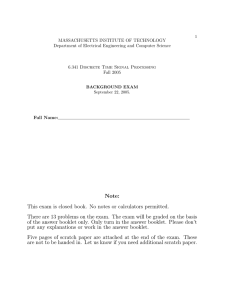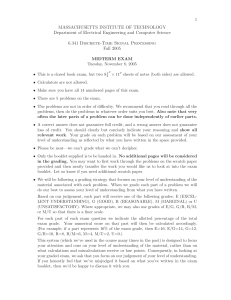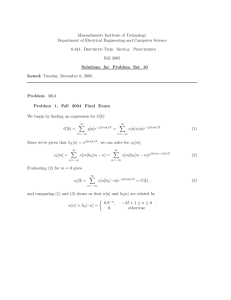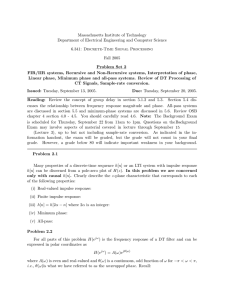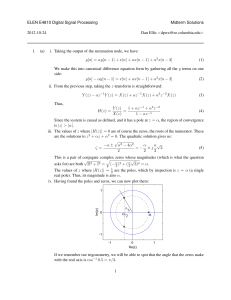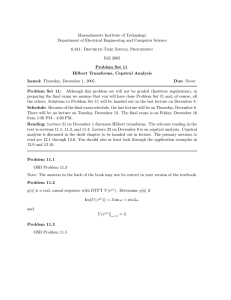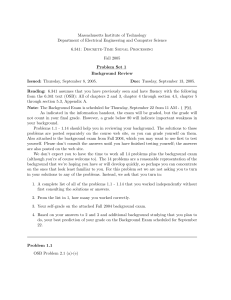Document 13513536
advertisement
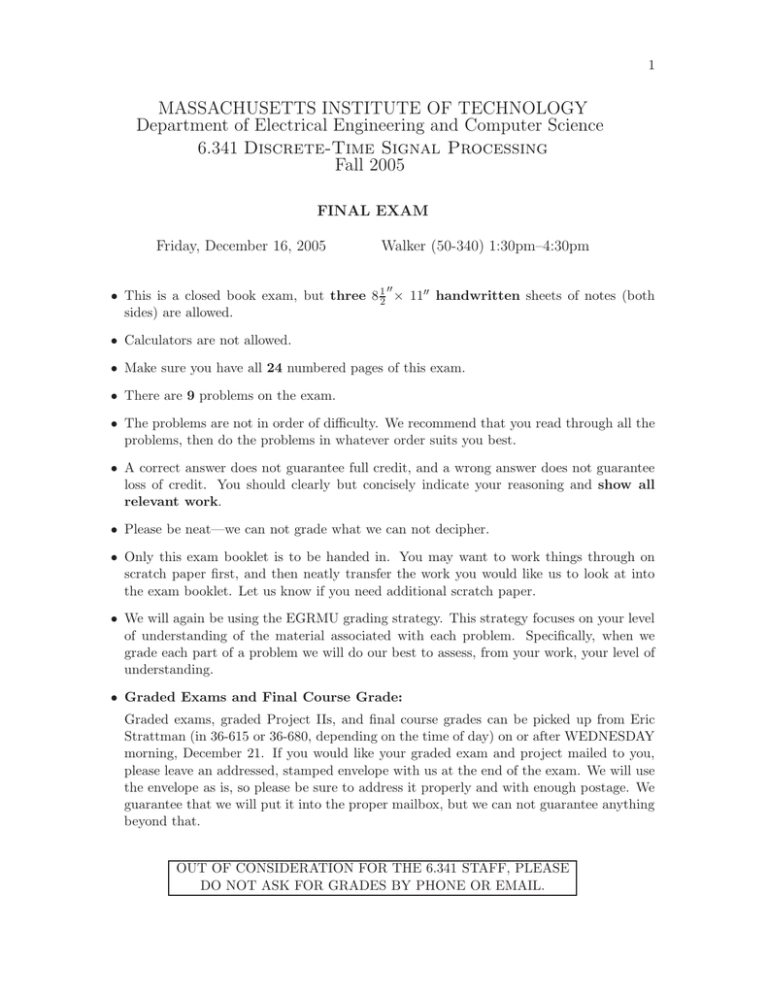
1
MASSACHUSETTS INSTITUTE OF TECHNOLOGY
Department of Electrical Engineering and Computer Science
6.341 Discrete-Time Signal Processing
Fall 2005
FINAL EXAM
Friday, December 16, 2005
Walker (50-340) 1:30pm–4:30pm
′′
• This is a closed book exam, but three 8 12 × 11′′ handwritten sheets of notes (both
sides) are allowed.
• Calculators are not allowed.
• Make sure you have all 24 numbered pages of this exam.
• There are 9 problems on the exam.
• The problems are not in order of difficulty. We recommend that you read through all the
problems, then do the problems in whatever order suits you best.
• A correct answer does not guarantee full credit, and a wrong answer does not guarantee
loss of credit. You should clearly but concisely indicate your reasoning and show all
relevant work.
• Please be neat—we can not grade what we can not decipher.
• Only this exam booklet is to be handed in. You may want to work things through on
scratch paper first, and then neatly transfer the work you would like us to look at into
the exam booklet. Let us know if you need additional scratch paper.
• We will again be using the EGRMU grading strategy. This strategy focuses on your level
of understanding of the material associated with each problem. Specifically, when we
grade each part of a problem we will do our best to assess, from your work, your level of
understanding.
• Graded Exams and Final Course Grade:
Graded exams, graded Project IIs, and final course grades can be picked up from Eric
Strattman (in 36-615 or 36-680, depending on the time of day) on or after WEDNESDAY
morning, December 21. If you would like your graded exam and project mailed to you,
please leave an addressed, stamped envelope with us at the end of the exam. We will use
the envelope as is, so please be sure to address it properly and with enough postage. We
guarantee that we will put it into the proper mailbox, but we can not guarantee anything
beyond that.
OUT OF CONSIDERATION FOR THE 6.341 STAFF, PLEASE
DO NOT ASK FOR GRADES BY PHONE OR EMAIL.
2
THIS PAGE IS INTENTIONALLY LEFT BLANK. YOU CAN USE IT AS SCRATCH
PAPER, BUT NOTHING ON THIS PAGE WILL BE CONSIDERED DURING GRADING.
3
MASSACHUSETTS INSTITUTE OF TECHNOLOGY
Department of Electrical Engineering and Computer Science
6.341 Discrete-Time Signal Processing
Fall 2005
FINAL EXAM
Friday, December 16, 2005
NAME:
Problem
1 (a)
1 (b)
2 (a)
2 (b)
3 (a)
3 (b)
3 (c)
4 (a)
4 (b)
4 (c)
4 (d)
5 (a)
5 (b)
6
7 (a)
7 (b)
8
9
Total
Grade
Points Grader
/5
/5
/6
/6
/4
/4
/4
/3
/3
/4
/5
/6
/6
/10
/6
/6
/8
/9
/100
4
Problem 1 (10%)
[5%] (a) x[n] is a real-valued, causal sequence with discrete-time Fourier transform X(ejω ). De­
termine a choice for x[n] if the imaginary part of X(ejω ) is given by:
Im{X(ejω )} = 3 sin(2ω) − 2 sin(3ω)
Work to be looked at and answer:
5
Name:
[5%] (b) yr [n] is a real-valued sequence with discrete-time Fourier transform Yr (ejω ). The sequences
yr [n] and yi [n] in Figure 1-1 are interpreted as the real and imaginary parts of a complex
sequence y[n], i.e. y[n] = yr [n] + jyi [n].
yr [n]
yr [n]
y[n] = yr [n] + jyi [n]
H(ejω )
yi [n]
Figure 1-1: System for obtaining y[n] from yr [n].
Determine a choice for H(ejω ) in Figure 1-1 so that Y (ejω ) is Yr (ejω ) for negative fre­
quencies and zero for positive frequencies between −π and π, i.e.
�
Yr (ejω ), −π < ω < 0
Y (ejω ) =
0,
0<ω<π
Work to be looked at and answer:
6
Problem 2 (12%)
Consider the system shown in Figure 2-1, with H1 (ejω ) and H2 (jΩ) as depicted in Figure 2-2.
x[n]
y[n]
2
jω
H1 (e )
H2 (jΩ)
D/C
C/D
T1
3
T2
Figure 2-1: System for calculating y[n] from x[n].
H1 (ejω )
1
−π
Periodic, with a period of 2π
ω
−ω0
ω0
π
H2 (jΩ)
1
−Ω0
Ω0
Ω
Figure 2-2: Frequency responses of discrete-time LTI filter H1 and continuous-time LTI filter
H2 .
Name:
7
[6%] (a) If T1 = T2 = 10−4 s and Ω0 = 4πT1 , is there a choice of ω0 > 0 for which the overall
system from x[n] to y[n] in Figure 2-1 is a discrete-time LTI system? If so, specify at
least one non-zero value of ω0 for which the system is LTI. Otherwise explain why the
system cannot be LTI.
Work to be looked at and answer:
[6%] (b) For this part, assume that T1 = 10−4 s and ω0 = π. Determine the most general conditions
on Ω0 > 0 and T2 , if any, so that the overall system from x[n] to y[n] in Figure 2-1 is an
LTI system.
Work to be looked at and answer:
8
Problem 3 (12%)
The following are three proposed identites involving compressors and expanders. For each, state
whether or not the proposed identity is valid. If your answer is that it is valid, explicitly show
why. (In doing this you may make use of the known identities on page 11.) If your answer is
no, explicitly give a simple counterexample.
[4%] (a) Proposed identity (a):
2
Half-sample delay
z −1
2
Work to be looked at and answer:
9
Name:
[4%] (b) Proposed identity (b):
z −1
z
2
h[n]
2
2
h[n + 1]
2
z
Work to be looked at and answer:
z −2
10
[4%] (c) Proposed identity (c):
A
L
A
L
where L is a positive integer, and A is defined in terms of X(ejω ) and Y (ejω ) (the respec­
tive DTFTs of A’s input and output) as:
x[n]
A
�
�L
Y (ejω ) = X(ejω )
Work to be looked at and answer:
y[n]
11
Name:
Correct identities you may refer to without proof
Noble identities:
M
H(z M )
H(z)
H(z)
L
M
L
H(z L )
Half-sample delay:
D/C
h(t) = δ(t −
T
2)
T
C/D
T
Half-sample delay
12
Problem 4 (15%)
We find in a treasure chest a zero-phase FIR filter h[n] with associated DTFT H(ejω ), shown
in Figure 4-1.
1.2
1
Filter response
0.8
0.6
0.4
0.2
0
−0.2
−1
−0.8
−0.6
−0.4
−0.2
0
0.2
0.4
0.6
0.8
1
Normalized frequency ω (×π radians/sample)
Figure 4-1: Plot of H(ejω ) from −π ≤ ω ≤ π.
The filter is known to have been designed using the Parks-McClellan (PM) algorithm, as sum­
marized on page 15 of this exam. The input parameters to the PM algorithm are known to
have been:
• Passband edge ωp : 0.4π
• Stopband edge ωs : 0.6π
• Ideal passband gain Gp : 1
• Ideal stopband gain Gs : 0
• Error weighting function W (ω) = 1
The value of the input parameter N to the algorithm is not known.
Name:
13
Also along with the plot is a fortune in gold, to be claimed by whoever can reproduce the filter
with the Parks-McClellan algorithm for these specifications and with an appropriate value of
N . Multiple winners share the gold. You are the sole referee and judge.
Two entries have been submitted, each with a different associated value for the input parameter
N to the algorithm.
• Entry 1: N = N1
• Entry 2: N = N2 > N1
Both entrants claim to have obtained the required filter using exactly the same Parks-McClellan
algorithm and input parameters, except for the value of N .
After inspecting both entries, you determine that they both have DTFTs identical to Figure
4-1, so you deem both of them winners.
[3%] (a) What are possible values for N1 ?
Work to be looked at and answer:
[3%] (b) What are possible values for N2 > N1 ?
Work to be looked at and answer:
14
[4%] (c) Are the impulse responses h1 [n] and h2 [n] of the two filters submitted by entrants 1 and
2 identical?
Work to be looked at and answer:
[5%] (d) Both entrants claim that there can only be one winner, since the alternation theorem
requires “uniqueness of the rth-order polynomial.” If your answer to (c) is yes, explain
why the alternation theorem is not violated. If your answer is no, show how the two
filters, h1 [n] and h2 [n] respectively, relate.
Work to be looked at and answer:
15
Name:
The Parks-McClellan algorithm for zero-phase lowpass filter design:
The algorithm for approximating a lowpass design with a zero-phase PM filter takes as input
parameters the following:
• Passband edge frequency ωp
• Stopband edge frequency ωs
• Ideal passband gain Gp
• Ideal stopband gain Gs
• Error weighting function W (ω)
• Length N of the filter response h[n], where
h[n] = 0 for |n| >
N −1
,
2
and N must be odd.
The algorithm returns a filter impulse response which satisfies the alternation theorem, stated
below.
Alternation theorem: Let FP denote the closed subset of the disjoint union of closed subsets
of the real axis x. Then
r
�
P (x) =
ak xk
k=0
is an rth-order polynomial. Also, DP (x) denotes a given desired function of x that is continuous
on FP ; WP (x) is a positive function, continuous on FP , and
EP (x) = WP (x) [DP (x) − P (x)]
is the weighted error. The maximum error is defined as
�E� = max |EP (x)| .
x∈FP
A necessary and sufficient condition that P (x) be the unique rth-order polynomial that mini­
mizes �E� is that EP (x) exhibit at least (r +2) alternations; i.e., there must exist at least (r +2)
values xi in FP such that x1 < x2 < · · · < xr+2 and such that EP (xi ) = −EP (xi+1 ) = ±�E�
for i = 1, 2, . . . , (r + 1).
16
Problem 5 (12%)
[6%] (a) X(ejω ) is the DTFT of the discrete-time signal
� �n
1
x[n] =
u[n].
2
Find a length-5 sequence g[n] whose 5-point DFT G[k] represents samples of the DTFT
of x[n], i.e.
g[n] = 0 for n < 0, n > 4
and
G[k] = X(ej
Work to be looked at and answer:
2πk
5
) for k = 0, 1, . . . , 4.
17
Name:
[6%] (b) Let w[n] be a sequence that is strictly non-zero for 0 ≤ n ≤ 9 and zero elsewhere, i.e.
w[n] =
� 0,
0≤n≤9
w[n] = 0
otherwise
Determine a choice for w[n] such that its DTFT W (ejω ) is equal to X(ejω ) at the fre­
quencies ω = 2πk
5 , k = 0, 1, . . . , 4, i.e.
W (ej
2πk
5
) = X(ej
Work to be looked at and answer:
2πk
5
) for k = 0, 1, . . . , 4.
18
Problem 6 (10%)
A system for the discrete-time spectral analysis of continuous-time signals is shown in Figure 6­
1.
xc (t)
x[n]
v[n]
V [k]
C/D
32-point DFT
T = 10−3 s
w[n]
Figure 6-1: Spectral analysis system.
w[n] is a rectangular window of length 32:
�
(1/32),
w[n] =
0,
0 ≤ n ≤ 31
otherwise
60
55
20 log10(|V[k]|) (dB)
50
45
40
35
30
25
20
0
5
10
15
20
k
Figure 6-2: Output |V [k]| in dB
25
30
19
Name:
Listed below are ten signals, at least one of which was the input xc (t). Indicate which signal(s)
could have been the input xc (t) which produced the plot of |V [k]| shown in dB units in Figure
6-2. As always, provide reasoning for your choice(s).
x1 (t) = 1000 cos(230πt)
x6 (t) = 1000ej(250)πt
x2 (t) = 1000 cos(115πt)
x7 (t) = 10 cos(250πt)
x3 (t) = 10ej(460)πt
x8 (t) = 1000 cos(218.75πt)
j(230)πt
x4 (t) = 1000e
x5 (t) = 10ej(230)πt
Work to be looked at and answer:
x9 (t) = 10ej(200)πt
x10 (t) = 1000ej(187.5)πt
20
Problem 7 (12%)
x[n] is a finite-length sequence of length 1024, i.e.
x[n] = 0 for n < 0, n > 1023.
The autocorrelation of x[n] is defined as
Rxx [m] =
∞
�
x[n]x[n + m],
n=−∞
and XN [k] is defined as the N -point DFT of x[n], with N ≥ 1024.
We are interested in computing Rxx [m]. A proposed procedure begins by first generating the
N -point inverse DFT of |XN [k]|2 to obtain an N -point sequence gN [n], i.e.
�
�
gN [n] = N-point IDFT |XN [k]|2 .
[6%] (a) Determine the minimum value of N so that Rxx [m] can be obtained from gN [n]. Also
specify how you would obtain Rxx [m] from gN [n].
Work to be looked at and answer:
Name:
21
[6%] (b) Determine the minimum value of N so that Rxx [m] for |m| ≤ 10 can be obtained from
gN [n]. Also specify how you would obtain these values from gN [n].
Work to be looked at and answer:
22
Problem 8 (8%)
A system for examining the spectral content of a signal x[n] is shown in Figure 8-1. The filters
h[n] in each channel are identical three-point non-causal FIR filters and have impulse response
h[n] = h0 δ[n] + h1 δ[n + 1] + h2 δ[n + 2].
The filter outputs are sampled at n = 0 to obtain the sequence yk [0], k = 0, 1, 2, 3.
n=0
h[n]
n=0
e−j2πn(0/4)
h[n]
x[n]
y0 [0]
y0 [n]
y1 [0]
y1 [n]
n=0
e−j2πn(1/4)
h[n]
y2 [0]
y2 [n]
n=0
e−j2πn(2/4)
h[n]
y3 [0]
y3 [n]
e−j2πn(3/4)
Figure 8-1: Filter bank network.
An alternative to the system in Figure 8-1 has been proposed using a 4-point DFT as shown
in Figure 8-2.
LTI
x[n]
p[n]
g[n]
4-point
DFT
r[n]
Figure 8-2: Alternative system.
P [k] =
�3
−j2πkn/4
n=0 p[n]e
Name:
Determine g[n] and r[n] so that P [k] = yk [0].
Work to be looked at and answer:
23
24
Problem 9 (9%)
Consider the system shown in Figure 9-1. The subsystem from x[n] to y[n] is a causal, LTI
system implementing the difference equation
y[n] = x[n] + ay[n − 1].
x[n] is a finite length sequence of length 90, i.e.
x[n] = 0
for n < 0 and n > 89.
n=M
x[n]
y[M ]
y[n]
z −1
a
Figure 9-1: System for calculating y[M ] from x[n].
Determine a choice for the complex constant a and a choice for the sampling instant M so that
�
y[M ] = X(ejω )�
ω=2π/60
Work to be looked at and answer:
END OF EXAM
